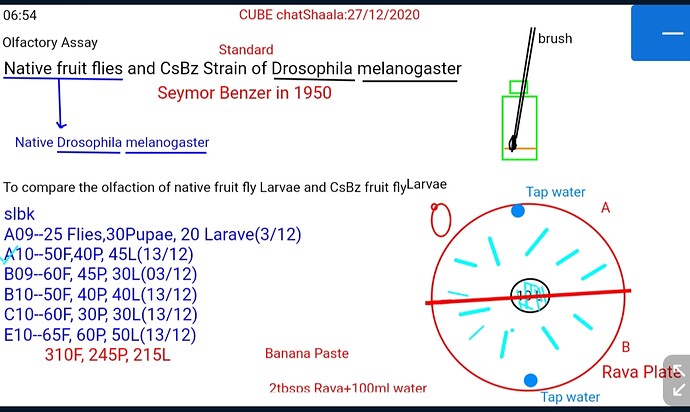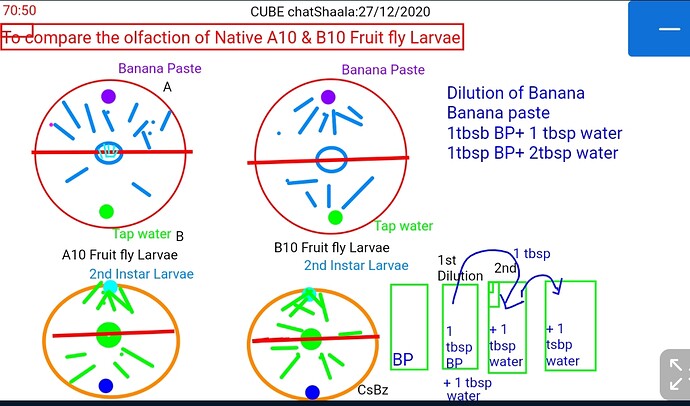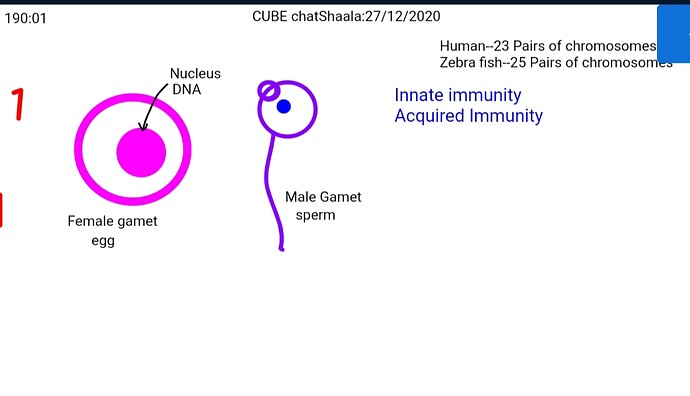Whiteboard screenshot from yesterday’s (27/12/2020)
CUBE CHATSHAALA
Olfactory Assay
How to compare the olfaction of Native fruit flies and standard CsBz strain of Drosophila melanogaster Larvae.
We had discussed that what’s the objective to compare olfaction?..
@saswathy679 @Lydia Drosphila discovered that what could be the alternative to perform olfactory assay in cube home lab…
Right hand side drawing shows Rava plate/ olfactory which needs to calibrate?.
@saswathy679 had very well explained how to calliberate olfactometer…
Amazing a plate can act as an instrument…
@saswathy679 discovered that olfaction can also be compared in different single line Cultures that
@saswathy679 has been maintaining in her
CUBE HOME LAB.
Discussion has led to understand what an olfaction? What conclusion we can make when we compare olfaction of two different single line Cultures of fruit fly…
How to make dilution?
An interesting discussion on innate immunity of zebra fish…
How to differentiate in between fertilized and unfertilzed eggs?..
What’s an egg?.
Both the kinds of egg are prone to bacterial or fungal infection, but fertilized eggs can save itself by eliminating pathogen through phagocytosis whereas unfertilzed egg fails to do this and Hence got dicomposed by bacteria…
What happens during fertilization?.how many chromosomes does an egg cell contains?.
What’s the no. Of chromosomes in Human?..
How innate immunity is different from acquired immunity?.
References shared during the cube chatshaala discussion for innate immunity in Zebra fish…
1. As early as one day after fertilization (dpf), zebrafish embryos display phagocytic activity towards
microbial infections [12] and are able to mount an innate immune response
https://www.ncbi.nlm.nih.gov/pmc/articles/PMC3395205/
2. Pathogen Recognition and Activation of the Innate Immune Response in Zebrafish
Michiel van der Vaart, Herman P. Spaink, and Annemarie H. Meijer
*https://www.ncbi.nlm.nih.gov/pmc/articles/PMC3395205/
3. Herbomel P, Thisse B, Thisse C. Ontogeny and behaviour of early macrophages in the zebrafish
embryo. Development. 1999;126(17):3735–3745. [PubMed] [Google Scholar]
4. Development
1999 Sep;126(17):3735-45.
5.Ontogeny and behaviour of early macrophages in the zebrafish embryo
P Herbomel 1 , B Thisse, C Thisse
6.The haploid zebrafish genome has 25 chromosomes, most of which are difficult to distinguish. These
chromosomes contain about 1.7 X l09 base pairs of DNA, about half the mammalian genome
size.https://www.sciencedirect.com/science/article/pii/S0091679X08618981
7.Zebrafish have 25 chromosomes and their genome consists of about 1.5 x 10 billion basepairs,
compared with mammalian genome sizes of about 3 x 10 billion basepairs. It is currently unknown how
many genes there are in the zebrafish, but it is very likely that the total number will be very close to the
one expected for mammalian genomes.
%20lay,hours%20of%20normal%20zebrafish%20development.&text=Zebrafish%20have
%2025%20chromosomes%20and,3%20x%2010%20billion%20basepairs.
8. Zebra fish larvae develop innate immune cells within 2 days post fertilization (dpf) while the adaptive
immune system is not present until approximately 3 weeks post fertilization (10, 11), making it a
favorable model to study innate immune-dominant responses.Sep 5,
2020https://www.researchgate.net/publication/51675430_Zebrafish_Model_for_the_Study_of_Inflammat
ion_and_the_Innate_Immune_Response_to_Infectious_Diseases
9. After fertilization, larvae survive with only the innate immune responses because adaptive immune
system is morphologically and functionally mature only after 4-6 weeks postfertilization. This temporal
separation provides a suitable system to study the vertebrate innate immune response in vivo,
independently from the adaptive immune
response.https://www.researchgate.net/publication/51675430_Zebrafish_Model_for_the_Study_of_Infla
mmation_and_the_Innate_Immune_Response_to_Infectious_Diseases
10. It was recently shown that zebrafish embryonic macrophages efficiently engulf E. coli bacteria from
blood- and fluid-filled cavities, while neutrophils are hardly capable of phagocytosing bacteria present in
fluids https://www.ncbi.nlm.nih.gov/pmc/articles/PMC3395205/




